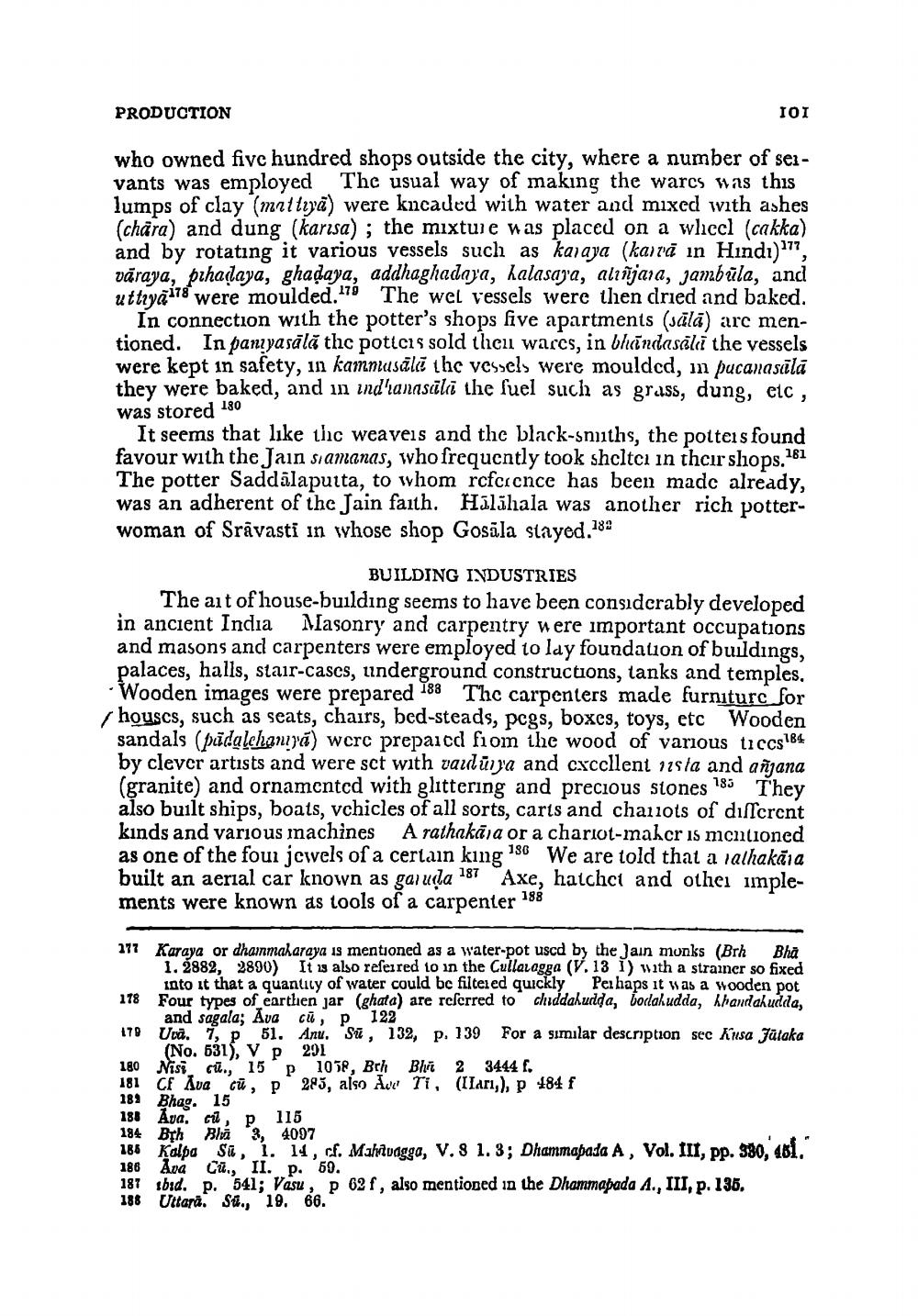________________
PRODUCTION
ΤΟΙ
who owned five hundred shops outside the city, where a number of seivants was employed The usual way of making the warcs was this lumps of clay (mattia) were kncaded with water and mixed with ashes (chara) and dung (karısa); the mixture was placed on a whiccl (cakka) and by rotating it various vessels such as karaya (karra in Hindi)*77, vāraya, pihalaya, ghadaya, addhaghaday'a, halasaja, aliñjara, jambüla, and uttryä 178 were moulded.179 The wel vessels were then dried and baked.
In connection with the potter's shops five apartments (sala) arc mentioned. In paniyasalā thc poticis sold thou wares, in bhindasálii the vessels were kept in safety, in kannasälī the vessels were moulded, in pucanasala they were baked, and in indianastilī the fuel such as grass, dung, etc, was stored 180
It seems that like thic weavers and the black-smiths, the potters found favour with the Jain samanas, who frequently took sheltei in their shops.161 The potter Saddälaputta, to whom rcfcicnce has been made already, was an adherent of the Jain faith. Hālāhala was another rich potterwoman of Srāvasti in whose shop Gosāla stayed.189
BUILDING INDUSTRIES The ait of house-building seems to have been considerably developed in ancient India Masonry and carpentry were important occupations and masons and carpenters were employed to lay foundation of buildings, palaces, halls, stair-cascs, underground constructions, tanks and temples, Wooden images were prepared 188 Thc carpenters made furniture for houscs, such as seats, chairs, bed-steads, pegs, boxes, toys, etc Wooden sandals (pdalchanija) were prepaicd from the wood of various ticcs184 by clever artists and were sct with vaidūnya and cxcellent nista and añana (granite) and ornamented with glittering and precious stones 185 They also built ships, boats, vchicles of all sorts, carts and chariots of diffcrcnt kınds and various machines A rathakāla or a chariot-maher is mentioned as one of the four jcwels of a certain king 186 We are told that a lathakāla built an aerial car known as garuda 187 Axe, hatchct and other implements were known as tools of a carpenter 188
178
277 Karaya or dhaimaharaya is mentioned as a water-pot uscd by the Jain monks (Brh Bha
1.2882, 2890) It is also referred to in the Cullavagga (V. 13 l) with a strainer so fixed into it that a quantity of water could be filtered quickly Perhaps it was a wooden pot Four types of earthen jar (ghata) are referred to chiddahudda, bodlahudda, khandahudda,
and sagala; Ava cū, p 122 179 Ura. 7, p 51. Anu. Sú, 132, p. 139 For a similar description sec Kusa Jataka
(No. 531), V P 291 180 Nisi cū. 15 p 1058, Brh Bhit 2 3444 f. 181 Cf Ava cū, P 283, also Ad Ti, (IIarı,), p 484 f 182 Bhag. 15 186 Ava, cil, p 115 184 Bth Blă 3, 4097 186 Kalpa si, 1. 14, cf. Maktuagga, V. 8 1.3; Dhammapada A, Vol. III, pp. 580, 481." 186 Ava Cū.II. p. 50. 187 ibid. p. 541; Vasu, p 62 f, also mentioned in the Dhammapada A., III, p. 135. 188 Uttara. Su., 19. 66.




